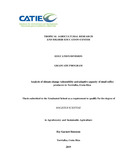Mostrar el registro sencillo del ítem
Analysis of climate change vulnerability and adaptive capacity of small coffee producers in Turrialba, Costa Rica
| dc.contributor.advisor | Virginio Filho, Elias de Melo | |
| dc.contributor.author | Garnett Simmons, Fay | |
| dc.coverage.spatial | Turrialba, Costa Rica | |
| dc.date.accessioned | 2019-12-12T21:57:29Z | |
| dc.date.available | 2019-12-12T21:57:29Z | |
| dc.date.issued | 2019 | |
| dc.identifier.uri | https://repositorio.catie.ac.cr/handle/11554/9281 | |
| dc.description | Tesis (Mag. Sc.) - CATIE. Turrialba (Costa Rica), 2019 | es_ES |
| dc.description.abstract | In 2015, the Tropical Agricultural Research and Higher Education Center (CATIE) and the Regional Climate Change Program (RCCP) developed a rapid assessment tool to help technicians and producers in Central America measure the vulnerability and adaptive capacity of coffee (Coffea arabica) farms affected by climate change. Supporting this initiative, the Central American Program for Integral Management of Coffee Rust (Hemilia vastatrix) (PROCAGICA) provided support to develop a reference manual guiding the process in Costa Rica, where coffee is mainly cultivated by small producers who represent 97% of the total coffee producers (ICAFE, 2018). The present study was conducted between October 2018 and May 2019, and focused on applying the rapid assessment tool on 26 coffee farms (Organic, Agrosustainable and Conventional Systems) that belong to members of the Apoya Naturalba Coffee Association situated in Turrialba, Costa Rica. The purpose of the study was to determine the vulnerability and adaptive capacity of the farms using the rapid assessment tool, farm surveys and a participatory workshop. The data which was gathered, tabulated and analyzed with the use of features in Microsoft Excel and INFOSTAT (2012). Frequency tables, Contingency tables and Correspondence Analysis were used to analyze the data. Youth involvement in coffee activities was low to absent. The producers planted 8 or more traditional and improved varieties as well as diverse crops; and had a few small stock animals. The findings demonstrate that the farms are in 4 categories; Critical vulnerability and adaptive capacity; Average critical vulnerability and adaptive capacity; Regular vulnerability and adaptive capacity; and lastly, Moderate vulnerability and adaptive capacity. The most important limitations to coffee production were temperature increase (100%) and irregular rainfall (100%). Statistical analysis demonstrated that based on the sample size used; there was no association between the Category of Vulnerability and Adaptive capacity and the number of practices implemented on the farm. Neither were there any association between the number of practices and the type of system implemented by the producers. | es_ES |
| dc.description.sponsorship | CATIE - Centro Agronómico Tropical de Investigación y Enseñanza | es_ES |
| dc.format.extent | 95 páginas | |
| dc.language.iso | en | es_ES |
| dc.publisher | Centro Agronómico Tropical de Investigación y Enseñanza (CATIE) | es_ES |
| dc.relation.ispartof | Magister Scientiae en Agroforestería y Agricultura Sostenible | |
| dc.rights | info:eu-repo/semantics/openAccess | es_ES |
| dc.subject | CAMBIO CLIMÁTICO | |
| dc.subject | CLIMATE CHANGE | |
| dc.subject | PEQUEÑOS AGRICULTORES | |
| dc.subject | SMALLHOLDERS | |
| dc.subject | COFFEA | |
| dc.subject | FACTORES DE PRODUCCION | |
| dc.subject | PRODUCTION FACTORS | |
| dc.subject | PRODUCCION POTENCIAL | |
| dc.subject | PRODUCTION POSSIBILITIES | |
| dc.subject | TURRIALBA -- COSTA RICA | |
| dc.title | Analysis of climate change vulnerability and adaptive capacity of small coffee producers in Turrialba, Costa Rica | es_ES |
| dc.type | Tesis de maestría | es_ES |
Ficheros en el ítem
Este ítem aparece en la(s) siguiente(s) colección(ones)
-
Tesis [3083]


